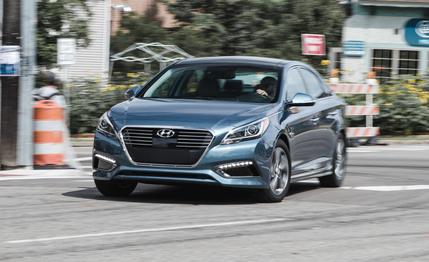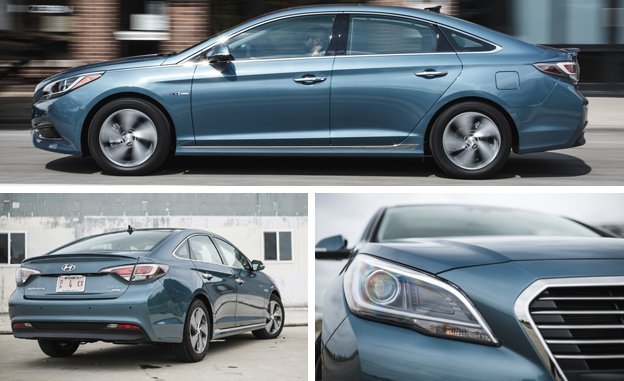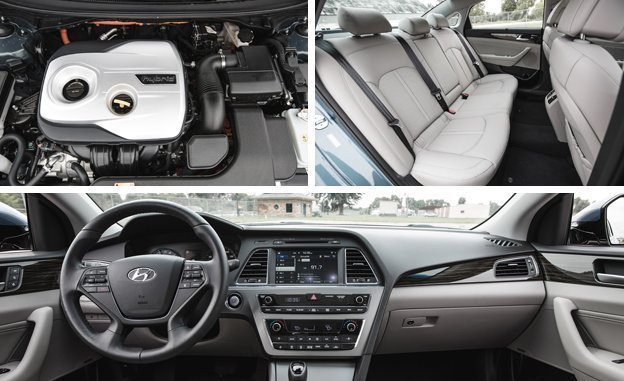 Instrumented Test
Instrumented Test
It’s not always easy being green. With the price of regular unleaded at four-year lows and big pickups and luxed-up SUVs and crossovers rolling off dealer lots at a fast clip, fewer buyers may be willing to put up with the unpredictable brakes, rubbery steering, and disconnected drivetrain feel associated with many mainstream hybrid sedans. And for those buyers who do prioritize fuel economy, most hybrid models’ vaunted EPA estimates seem to be achievable only on flat terrain, at country-club speeds, and in mild weather.
For 2016, the Sonata hybrid version 3.0 (our name, not Hyundai’s) addresses some of those shortcomings. Hyundai tackled the fuel-economy issue by shrinking the previous-gen model’s 2.4-liter four-cylinder gas engine to 2.0 liters but added direct injection along with a bigger battery pack and a more powerful electric motor. Gas-engine output dropped from 159 to 154 horsepower and torque plummeted from 154 to 140 lb-ft, but the lithium-polymer battery grew to 1.6 kWh and the electric motor gained 4 horsepower. EPA estimates rose from the previous version’s 36 mpg city and 40 mpg highway to 39/43 for our 2016 Limited test car. Observed fuel economy also notched up to 34 mpg under our leadfooted ministrations, besting our test results of the Ford Fusion hybrid (32 mpg) and Toyota Camry hybrid (31 mpg) but not the Honda Accord hybrid (41 mpg).
Performance-wise, the beefed-up electrics offset the gas-engine shrinkage; the 2016 Sonata hybrid runs from rest to 60 mph in the same 8.1 seconds as the 2013 model. While not nosebleed-inducing, the Sonata’s zero-to-60 time is a full second quicker than the Fusion hybrid’s, although it’s 0.9-second tardier than the 7.2-second sprints of the Camry and Accord hybrids. Hyundai has added a Driving Style Guide to the color display in the gauge cluster; the feature acts as sort of a car shrink, delivering feedback on whether your accelerator-pedal usage is economical, normal, or aggressive (as if you didn’t know).
One thing you’ll notice right away is the improved brake feel. For 2016, Hyundai reworked the blending of the hydraulic and battery-regenerating brake systems. Last year’s two-step feel is largely gone. Now, the regen braking comes in sooner for a more linear pedal response and more predictable stopping performance. Although we did experience moderate brake fade after a half-dozen full-ABS stops from 70 mph, the 183-foot 70-to-zero-mph stopping distance we recorded on the 2016 Sonata hybrid is considerably improved from the dismal 194-foot performance of the 2013 version. It’s now more in line with those of the Camry, Accord, and Fusion hybrids.

Lateral grip from the 215/55R-17 Kumho Solus low-rolling-resistance tires, while not great, improves from 0.73 g on the previous Sonata hybrid to 0.78—bringing it even with the skidpad performance of the Camry hybrid but below that of the Accord (0.80 g) and Fusion (0.85 g) hybrids. Although still lacking in road feedback, the linearity and weighting of the steering in the 2016 model is noticeably improved, as well.
Still, the defining characteristic of the Sonata hybrid is its use of a “conventional” six-speed step-shift automatic transmission. As does Porsche with its Cayenne and Panamera hybrids, Hyundai eschews the almost ubiquitous continuously variable automatics used in most other gas-electrics. We put “conventional” inside quotation marks because the hybrid’s electric motor resides where a fluid torque converter would be in a truly conventional automatic. But as a result, the Sonata hybrid’s drive quality, apart from the pleasing electric drive-off feel from rest, is as familiar as that of a nonhybrid. There is none of the distasteful disconnect between engine and road speeds as experienced in cars with CVTs. Hyundai also tightened up the shifts and tuned the electric-drive/gas-engine segues to be nearly imperceptible. And a drive-mode selector on the console allows you to tailor accelerator response and steering effort with Eco, Normal, and Sport settings.
The current-gen nonhybrid Sonata may have lost some of its previous Fluidic Sculpture mojo, but the hybrid version gets a measure of that back with a taller, Genesis-like extended grille and front fascia, plus extended rocker panels, a low-drag rear diffuser, LED running lamps and taillamps, and aerodynamic “Eco-spoke” aluminum wheels. Already the mid-size-sedan champ in interior volume as well as front legroom and front headroom, the gas-electric Sonata saw its hybrid battery relocated under the trunk floor, giving the 2016 Sonata hybrid top cargo honors among its class and allowing for pass-through access via a 60/40 fold-down back seat. There’s no spare tire onboard, though.

Our $30,925 2016 Sonata Limited test car’s luxury amenities included leather upholstery, heated and ventilated power front seats, a heated steering wheel, and heated rear seats, and it also packed safety gear such as a backup camera and blind-spot and rear cross-traffic monitoring. The $4500 Ultimate package added navigation with an 8.0-inch touch screen, a panoramic sunroof, a 400-watt premium audio system, HD radio, SiriusXM Travel Link, dynamic cruise control that can stop the car completely, auto high-beam control, lane-departure and forward-collision warning systems, and rear park assist. The as-tested price was a reasonable $35,765.
There are now other ways to get good fuel-economy numbers in a Sonata. The new 1.6-liter turbo Eco model, for instance, costs thousands less and scores an EPA-rated 28/38 mpg city/highway (we saw 30 mpg in our test of that model), while beating the hybrid to 60 mph by 1.4 seconds.
Nonetheless, if you’re worried about the expensive-to-replace lithium-polymer battery and related hybrid components, Hyundai has your back. The Sonata’s 10-year/100,000-mile powertrain/hybrid-component and 5-year/60,000-mile bumper-to-bumper warranties still top the segment, and Hyundai has upped the ante with a lifetime hybrid-battery warranty. How’s that for taking some of the stress out of saving the planet?